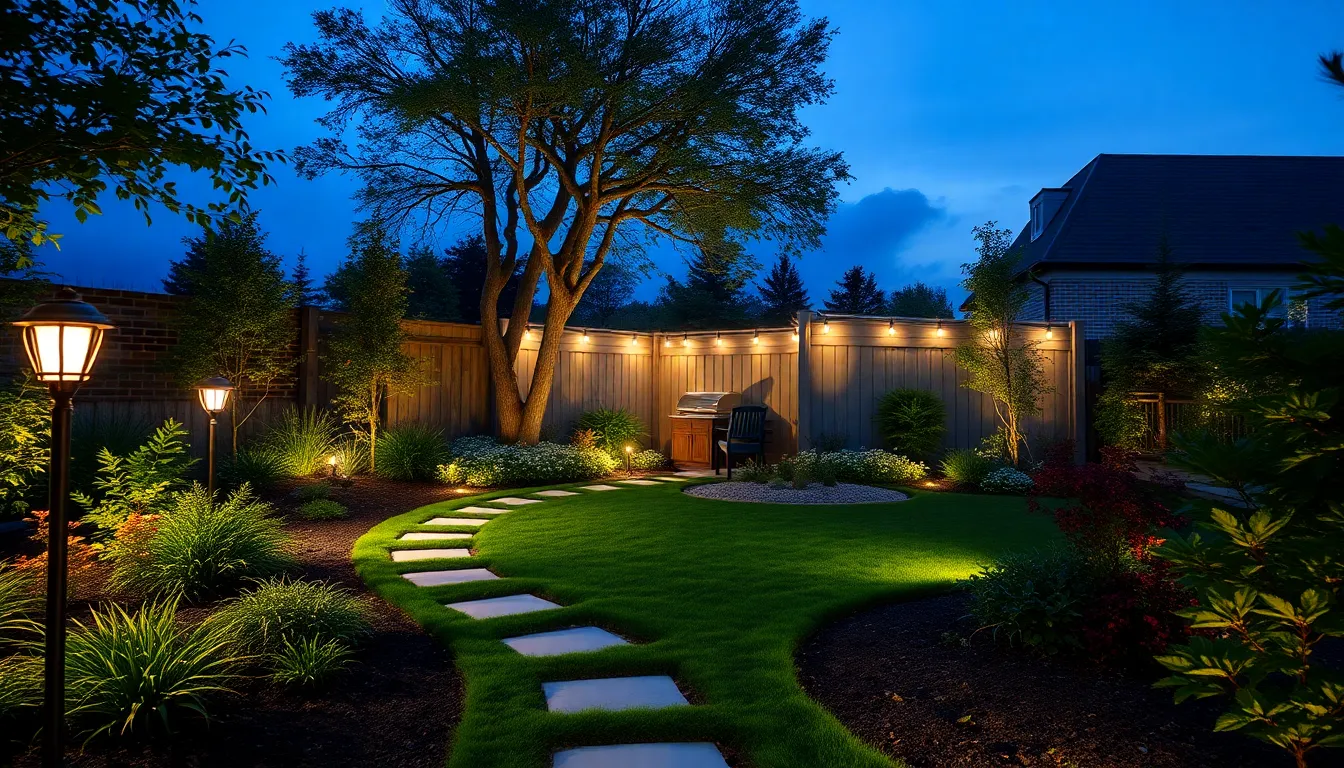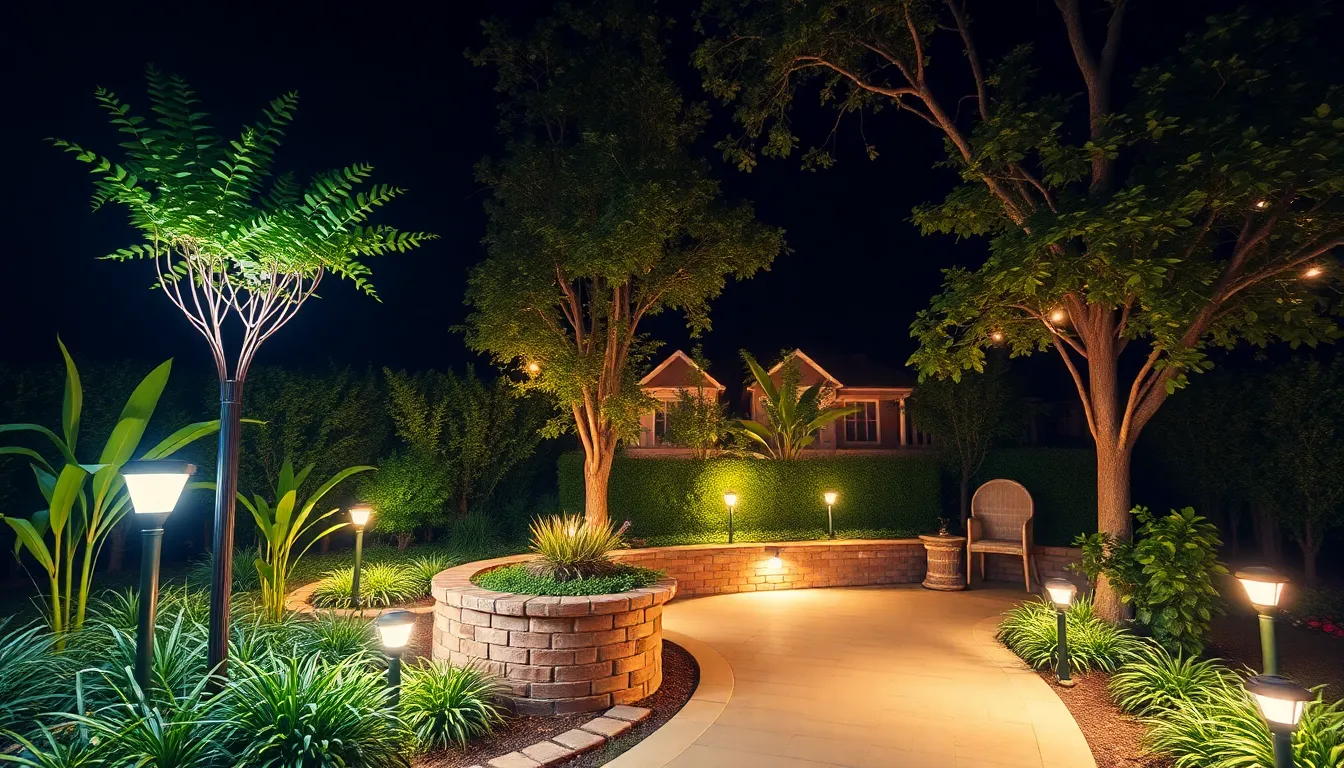Transforming a garden into a nighttime oasis is as simple as adding the right lighting. Garden lighting not only enhances the beauty of outdoor spaces but also extends the usability of the garden after sunset. With a variety of options available, from soft ambient lights to striking spotlights, homeowners can create a captivating atmosphere that highlights their garden’s unique features.
Effective garden lighting goes beyond mere aesthetics; it also ensures safety and security. Well-placed lights can illuminate pathways and entryways, preventing accidents and deterring unwanted visitors. As more people seek to maximize their outdoor enjoyment, understanding the principles of garden lighting becomes essential for any homeowner looking to elevate their landscape design.
Table of Contents
ToggleOverview of Garden Lighting
Garden lighting plays a crucial role in transforming outdoor environments into inviting spaces after sunset. Effective design combines aesthetics and functionality, offering various options to suit diverse settings and preferences.
Types of Garden Lighting
- Ambient Lighting: Ambient lighting establishes a warm and inviting atmosphere. It’s typically soft and diffused, providing general illumination for larger areas.
- Task Lighting: Task lighting focuses on specific areas to enhance usability. Examples include lights over pathways, seating areas, or gardens where detailed work occurs.
- Accent Lighting: Accent lighting highlights architectural features, plants, or artwork. Spotlights and floodlights create dramatic effects, drawing attention to focal points.
- Decorative Lighting: Decorative lighting enhances garden aesthetics while serving as an attraction. Lanterns, string lights, and unique fixtures add charm and character.
Benefits of Garden Lighting
- Enhanced Visibility: Properly illuminated pathways and driveways reduce accidents and increase safety for guests and residents.
- Extended Usability: With adequate lighting, outdoor spaces become functional at night, encouraging gatherings and leisure activities.
- Increased Security: Well-lit areas deter potential intruders and provide peace of mind for homeowners.
- Highlighting Features: Strategic lighting can emphasize landscaping, sculptures, or water features, enriching the overall appeal of the garden.
Considerations for Garden Lighting
Designing an effective garden lighting plan requires careful consideration of several factors:
- Placement: Light placement impacts visibility and ambiance. Position fixtures to illuminate spaces without creating harsh shadows.
- Brightness: Choose the right wattage or lumens to achieve the desired effect, balancing brightness and warmth for a pleasant atmosphere.
- Styles: Select lighting styles that complement existing architecture and landscape design, ensuring a cohesive look.
- Energy Efficiency: Opt for LED fixtures that consume less energy and offer longer lifespans compared to traditional incandescent bulbs.
Understanding garden lighting options and their application enhances outdoor spaces, creating secure, beautiful environments suitable for evening enjoyment.
Types of Garden Lighting

Garden lighting encompasses various types that serve different functions. Understanding these types helps homeowners create a well-illuminated and visually appealing outdoor space.
Solar-Powered Lights
Solar-powered lights utilize sunlight to generate energy during the day, enabling them to shine at night. These lights are easy to install, requiring no electrical wiring. Options include path lights, spotlights, and decorative fixtures. They are energy-efficient and environmentally friendly, making them ideal for eco-conscious homeowners. Solar-powered lights typically feature built-in sensors that enable automatic activation after sunset.
LED Lights
LED lights offer high efficiency and long lifespan, making them a popular choice for garden illumination. They consume less energy compared to traditional bulbs while producing bright light. Available in various styles, they can be used for ambient, task, and accent lighting. LED lights can also change colors, providing versatility in creating different moods. Their durability makes them suitable for outdoor use in various weather conditions.
Low Voltage Lighting
Low voltage lighting systems operate using a transformer to reduce the standard voltage, enhancing safety in outdoor environments. These lights require wiring but are easier to install than line voltage systems. Low voltage options include pathway lights, garden spotlights, and wall-mounted fixtures. They deliver beautiful illumination while being energy-efficient and cost-effective, often appealing to homeowners seeking comprehensive lighting solutions.
Benefits of Garden Lighting
Garden lighting offers numerous advantages that enhance the functionality and beauty of outdoor spaces after dark. Effective lighting transforms gardens into inviting areas for leisure and enjoyment while providing essential safety measures.
Enhanced Aesthetics
Enhanced aesthetics occur through strategically placed lights that highlight unique features. Uplighting can illuminate trees, shrubs, and sculptures, creating attractive focal points. Pathway lights guide visitors, adding charm and ensuring visibility. Layering different types of lighting, such as ambient and accent, establishes a warm and inviting atmosphere. Color-changing fixtures can also introduce dynamic visual interest, allowing homeowners to set the mood for different occasions.
Increased Safety and Security
Increased safety and security are crucial benefits of garden lighting. Proper illumination minimizes the risk of accidents by clearly marking walkways and steps. Regularly lit areas deter potential intruders, making gardens safer. Installing motion sensor lights bolsters security, automatically activating when movement is detected, thus enhancing peace of mind. Additionally, well-lit areas promote safe gatherings, encouraging family and friends to spend more time outdoors.
Installation Tips for Garden Lighting
Installing garden lighting requires careful planning and selection to achieve the desired effect. Following expert tips ensures the best results and transforms outdoor spaces.
Planning Your Layout
Planning improves functionality and aesthetics. Assess the garden’s size, shape, and architectural features before placement.
- Identify key areas: Determine which spaces require lighting, such as pathways, seating areas, and focal points.
- Create a lighting plan: Sketch a layout that indicates where to position each light fixture. Consider the balance of light levels across different areas.
- Think about ambiance: Aim for a harmonious blend of brightness; brighter lights in task areas and softer lights for ambiance.
- Use layering techniques: Combine different lighting types to create depth and dimension. Layering ensures visual interest and effectiveness.
Choosing the Right Fixtures
Choosing fixtures significantly impacts the overall look and function of garden lighting.
- Select appropriate types: Solar lights offer energy efficiency, while LED lights provide longevity and customizable options.
- Consider style: Match fixture designs with landscaping themes; traditional lanterns suit classic gardens, while sleek designs fit modern aesthetics.
- Evaluate brightness: Pay attention to lumens when selecting fixtures. Pathway lights typically require around 100-200 lumens, while accent lights may range from 200-400 lumens.
- Check durability: Choose weather-resistant materials for longevity in various climates. Stainless steel, copper, and plastic are common options.
Implementing these tips helps homeowners create a beautifully illuminated garden space that enhances both visual appeal and safety.
Maintenance of Garden Lighting
Maintaining garden lighting involves regular checks and upkeep to ensure optimal performance. Regular inspections help identify any burnt-out bulbs or damaged fixtures. Cleaning light fixtures periodically removes dirt and debris, which can obstruct light output.
Following are key maintenance tasks to keep garden lighting in top condition:
- Inspect bulbs: Regularly check for burnt-out bulbs and replace them promptly to maintain consistent illumination.
- Clean fixtures: Use a non-abrasive cleaner to clean light fixtures, ensuring maximum brightness.
- Check wiring: Examine wiring for signs of wear or damage; replace any frayed or corroded wires to prevent safety hazards.
- Adjust positions: Periodically adjust fixtures to maintain desired lighting angles and coverage as plants grow or garden layouts change.
- Test timers: Regularly test timers and automated systems to ensure lights operate at scheduled times; replace batteries in solar-powered lights as needed.
- Review energy efficiency: Evaluate lighting types and fixtures for energy efficiency; consider upgrading to LED options, which last longer and consume less energy.
Implementing these maintenance practices enhances safety and ensures that garden lighting continues to enrich outdoor spaces effectively.
Garden lighting plays a crucial role in transforming outdoor spaces into inviting and functional areas after dark. By carefully selecting and positioning various lighting types, homeowners can enhance their gardens’ beauty while ensuring safety and security. The right lighting not only highlights unique features but also creates a warm atmosphere for gatherings.
Regular maintenance is essential for keeping garden lighting in optimal condition. By following best practices for installation and upkeep, homeowners can enjoy their illuminated gardens for years to come. Ultimately, effective garden lighting allows for a seamless transition from day to night, making outdoor spaces more enjoyable and accessible.







